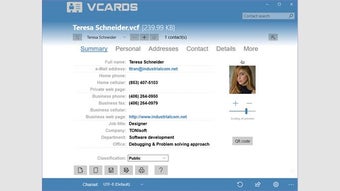vCards: A Convenient Way to Exchange Contact Information
Screenshots
vCards are a format for exchanging contact information. Originally created for e-mails, the format is now widely used for communication in various systems, including smartphones and social media. Many applications support vCard files, including e-mail, personal information managers, and smartphone contact files. vCards provide a quick and easy way to exchange contact information without the need for typing. Instead of manually inputting someone's contact details, you can simply send them a vCard and they can import it into their system. Additionally, vCards can be used to store favorites, such as restaurants or businesses, and can be shared with family and friends.
One of the main advantages of vCards is their compatibility. They can be used in different ways, such as in HTML, XML representation, or web pages. For email purposes, vCards can be embedded into HTML pages using hCard, which uses CSS class names to identify vCard properties. This allows for more advanced use cases and customization options. Furthermore, embedding vCard information into HTML pages does not affect the normal HTML markup.
While vCards offer great convenience for exchanging contact information, they do have limitations. One of the main drawbacks is the lack of support in certain applications or platforms. Although many applications support vCard files, there may be instances where compatibility issues arise. Additionally, vCards may not offer the same level of customization as other contact information formats.
In conclusion, vCards are a convenient way to exchange contact information quickly and easily. They are widely supported in various communication systems and offer compatibility with different formats. However, users should be aware of potential limitations and compatibility issues in certain applications or platforms.


